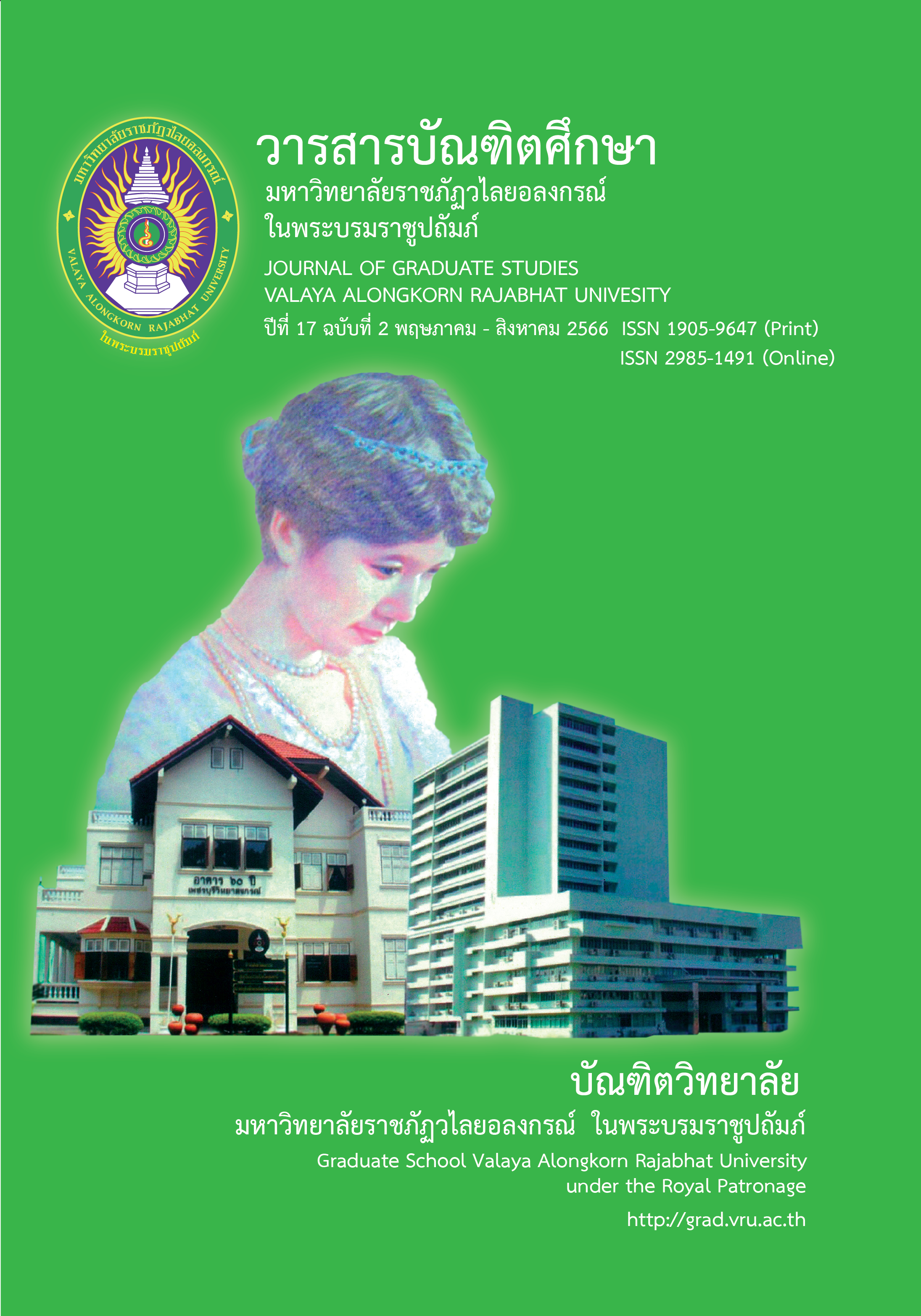THE GUIDELINES TO CREATE ARTS INTERVENTION IN TOURISM ROUTES THA TIEN COMMUNITY AND PAK KLONG MARKET AREA AND ITS INFLUENCE ON FOREIGN TOURISTS GROUPS
Main Article Content
Abstract
The objectives of this research were 1) to study the opinions of foreign tourists about the insertion of applied arts along the tourism route of Tha Tian community and Pak Klong market area, and 2) to develop an approach to inserting applied art works. Along the tourism route of Tha Tian community and Pak Khlong market area. The samples used in this research were 51 foreign tourists visiting Tha Tian community and Pak Khlong market area, and 5 local entrepreneurs. The sampling method was convenient sampling. Research tools include in-depth interviews, closed-ended questionnaire and a 5-level estimation scale questionnaire; statistics and data analysis. The frequency, percentage, mean and standard deviation were analyzed for the purpose of designing works of applied art.
The results of the research found that 1) the opinions of foreign tourists about the insertion of applied arts in Tha Tian community Pak Khlong market area. The photo gallery about the flower market lifestyle was at a high level with an average of 4.02. The tree arts use of tea bags from tea production was at a high level, an average of 3.73, and mascot symbol had an average of 3.98 at a moderate level, and 2) an approach for developing applied art insertion along the tourism route of Tha Tian community and Pak Khlong market area is a photo gallery of memories. By participating in conveying the way of life in the flower market area where tourists participate in storytelling through photographs tree arts which comes from waste materials from tea production instead of Chinese trade and flowers, which can represent the ethnic diversity of Thai, Chinese and Vietnamese people that have existed for a long time in the past, and mascot there is a distinctive sign from the Tha Tian community area. and Pak Khlong market area.
Article Details

This work is licensed under a Creative Commons Attribution-NonCommercial-NoDerivatives 4.0 International License.
บทความทุกเรื่องได้รับการตรวจความถูกต้องทางวิชาการโดยผู้ทรงคุณวุฒิ ทรรศนะและข้อคิดเห็นในบทความ Journal of Global of Perspectives in Humanities and Social Sciences (J-GPHSS) มิใช่เป็นทรรศนะและความคิดของผู้จัดทำจึงมิใช่ความรับผิดชอบของบัณฑิตวิทยาลัย มหาวิทยาลัยราชภัฏวไลยอลงกรณ์ ในพระบรมราชูปถัมภ์ กองบรรณาธิการไม่สงวนสิทธิ์การคัดลอก แต่ให้อ้างอิงแหล่งที่มา
References
BBC News. (2013). Gromit Unleashed 'seen by more than one million people. Retrieved from http://www.bbc.com/news/uk-england-bristol-24471519
Boonprasong, P. (2017). krabūankān plīanplǣng prayōt chaisō̜i nai tưkthǣo: kō̜ranī sưksā tưkthǣo bō̜riwēn thātīan Krung Thēp [Use transformation process of shophouses: a case study of THA TIEN’S shophouse, Bangkok]. Thesis, Doctor of Philosophy, Chulalongkorn University, Bangkok
Designboom. (2017). Azuma Makoto. Retrieved from https://www.designboom.com/tag/azuma-makoto
Fisher, W. (1984). The Narrative Paradigm: In the Beginning. Journal of Communication. 34, 74–89.
Han-gla, M. (2015). kān sāngsan nawattakam nai kān songsœ̄m khwāmkhēmkhæng khō̜ng thō̜ngthin: kō̜ranī sưksā kānchai tukkatā namchōk khō̜ng čhangwat khu mā mō tō prathēt Yīpun [Innovative Creation to Promoting Local Empowerment: A Case study of Mascot Character “KUMAMON” of Kumamoto Prefecture, Japan]. Thesis, Master of Political Science Program in Politics and Government, Chiang Mai University, Chiang Mai.
Huntrakool, H. (2012). samrūat phāksanām wan thī 10 Mithunāyon 2555 ri ̄wīw khō̜ng hō̜sin rūamsamai thao hong thai dīkhun [Field Survey June 10, 2012 Review of Tao Hong Tai Contemporary Art Gallery Deekun]. Retrieved from http://www.sac.or.th/databases/museumdatabase/review_inside_ByMember_Detail.php?id=430&CID =38749.
Kunawitchayanon, S. (2003). čhāk Sayām kao sū Thai mai: wādūai khwām phlik phan khō̜ng sinlapa čhāk praphēnī sū samai mai læ rūamsamai [From the old Siam to the new Thai: about the turning of art from tradition to modern and contemporary]. (2st ed.). Bangkok: Ban Hua Lam.
Kupkitaphun, K., & Bunjongmanee, P. (2020). nǣothāng kānphatthanā ʻongprakō̜p kānthō̜ngthīeo chœ̄ng sukkhaphāp khō̜ng nakthō̜ngthīeo chāo Yurōp nai čhangwat Pračhūap Khīrī Khan [The guidelines of health tourism development of european tourist in Prachuap khiri khan province]. Journal of Graduate Studies Valaya Alongkorn Rajabhat Univesity, 14(1), 2-13.
Laow, D. (2019). nithatsakān phāpthāi thīsut hǣng khwām ngām “Wonderful Indonesia” [The most beautiful photo exhibition “Wonderful Indonesia”]. Retrieved from https://www.matichon.co.th/publicize/news_1590832
Lockmasters, A. (2015). Love Locks: The Appeal and the History. Retrieved from http://www.Atlantalockmasters.com/love-locks-the-appeal-and-the-history
Lookjansuk, P., & Kultawanich, K. (2019). nithatsakān sadǣng phāpthāi phư̄a songsœ̄m phāplak thāngkān kasēt samư̄an ʻō̜nlāI samrap yaowachon run mai [Exhibition showing photos to promote the image of virtual agriculture online for the young generation]. Journal of Rattana Bundit University. 14(2), 1-16.
Lucaites, J., & Condit,C. (1985). Re-constructing Narrative Theory: A Functional Perspective. Journal of Communication. 35, 90–108.
Mathichon. (2012). Lost in Thailand nang thī thamhai chāo Čhīn hǣ thīeo Thai kwā sām lān knon [Lost in Thailand, the movie that made more than 3 million Chinese people flock to Thailand]. Retrieved from http://movie.sanook.com/33370
Ministry of Tourism and Sports. (2022). Sathiti nakthō̜ngthīeo phāinai prathēt pī 2559 [Statistics of domestic tourists in 2022]. Retrieved from https://www.mots.go. th/more_news_new.php?cid=657
Pinkeaw, W. (2011). čhariyatham kānnamsanœ̄ rāikān lao khāo banthœ̄ng khō̜ng sathānī thōrathat phān dāothīam [Broadcasting narrative entertainment news and morality via satellite television]. Thesis, Master Master of Arts Program in Mass Communication Administration, Thammasat University, Bangkok.
Prachachart. (2022). kasikō̜n Thai khāt pœ̄t prathēt dưng tāng chāt thīeo Thai dư̄an lamaitamkwā sām sǣn khon [Kasikornbank expects to open the country to attract foreigners to travel to Thailand at least 300,000 people per month]. Retrieved from https://www.prachachat.net/finance/news-919755
Songsam, N. (2008). thō̜t rahat “lưng” dūai thritsadī san ya witthayā [Deciphering the “phallic” with semiotic theory]. Retrieved from http://www.artgazine.com/shoutouts/viewtopic.php?t=2207
Srinarang, K. (2011). rō̜i Thai prǣ Na thātīan: sathāpattayakam chœ̄ng thotlō̜ng kō̜ranī sưksā yān thātīan [Experimaental architecture: case study Tha_tien community]. Veridian E-Journal SU. 4(1), 308-327.
Srisumanan, R. (1998). kān wikhro̜ kān lao rư̄ang thāng thōrathat nai rāikān samphāt [An analysis of televisual narrative in interview program]. Thesis, Master of Arts in Mass Communication, Chulalongkorn University, Bangkok.
Tankmano, S. (2014). Sinlapa nǣo kitčhakam: Sinlapa phư̄a chumchon læ sangkhom [Activity art: art for community and society]. Retrieved from http://v1.midnightuniv.org/midnight2545/document9740.html
Wongkam, K. (2021). “mātkhō̜t” khā rǣk thœ̄ tūa kātūn songsœ̄m kānthō̜ngthīeo chœ̄ng watthanatham thō̜ngthin ["Mascot" cartoon characters promote local cultural tourism]. Retrieved from http://www.ias.chula.ac.th/article/มาสคอต-คาแรกเตอร์ตัวก/


